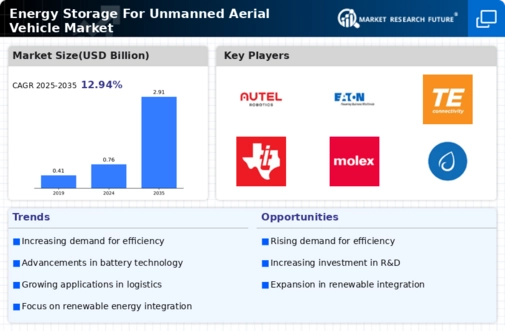Regulatory Support and Incentives
Government regulations and incentives play a crucial role in shaping the Global Energy Storage For Unmanned Aerial Vehicle Market Industry. Many countries are implementing policies that encourage the use of UAVs for commercial purposes, which often includes financial incentives for adopting advanced energy storage technologies. For example, regulatory frameworks that promote green energy solutions can facilitate the integration of renewable energy sources into UAV operations. This support not only fosters innovation but also drives the demand for efficient energy storage systems, thereby enhancing the overall market landscape.
Emerging Markets and Global Expansion
The Global Energy Storage For Unmanned Aerial Vehicle Market Industry is witnessing expansion into emerging markets, where the adoption of UAV technology is on the rise. Countries in Asia-Pacific and Latin America are increasingly recognizing the potential of UAVs for various applications, including disaster management and infrastructure inspection. This trend is expected to create new opportunities for energy storage solutions tailored to the specific needs of these regions. As these markets develop, the demand for efficient and reliable energy storage systems will likely increase, further contributing to the overall growth of the industry.
Increasing Demand for UAV Applications
The Global Energy Storage For Unmanned Aerial Vehicle Market Industry is driven by the rising demand for UAVs across various sectors, including agriculture, surveillance, and logistics. As industries increasingly adopt UAVs for tasks such as crop monitoring and package delivery, the need for reliable energy storage solutions becomes paramount. This trend is evidenced by the growing number of commercial UAV operations, which require longer flight durations and greater payload capacities. Consequently, energy storage technologies must evolve to meet these demands, further propelling market growth and innovation in energy storage systems.
Environmental Sustainability Initiatives
The Global Energy Storage For Unmanned Aerial Vehicle Market Industry is increasingly influenced by environmental sustainability initiatives. As concerns regarding climate change and carbon emissions grow, there is a push for cleaner and more efficient energy solutions in UAV operations. This has led to a focus on developing energy storage systems that utilize renewable energy sources, such as solar or wind power. The integration of such systems can significantly reduce the carbon footprint of UAVs, making them more appealing to environmentally conscious consumers and businesses, thus driving market growth.
Technological Advancements in Battery Systems
The Global Energy Storage For Unmanned Aerial Vehicle Market Industry is experiencing rapid advancements in battery technology, particularly lithium-ion and solid-state batteries. These innovations enhance energy density, reduce weight, and improve charging times, which are critical for UAV performance. For instance, the introduction of high-capacity lithium-sulfur batteries could potentially increase flight times significantly. As a result, the market is projected to grow from 0.76 USD Billion in 2024 to 2.91 USD Billion by 2035, reflecting a compound annual growth rate of 13.0% from 2025 to 2035. This growth underscores the importance of efficient energy storage solutions in the UAV sector.



























Leave a Comment